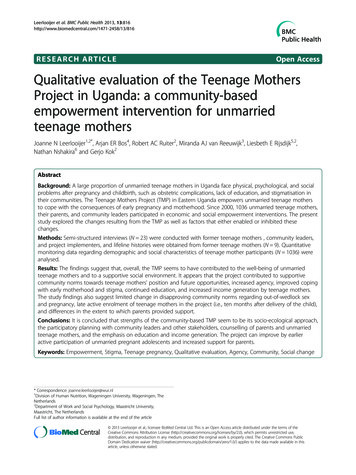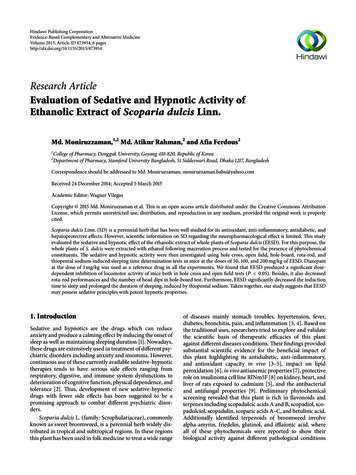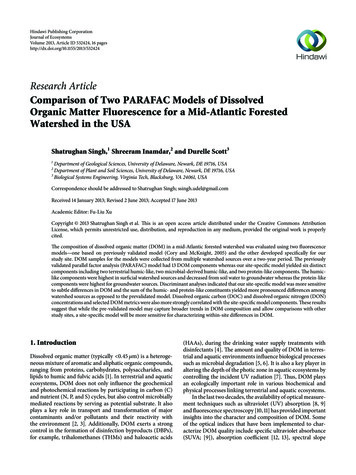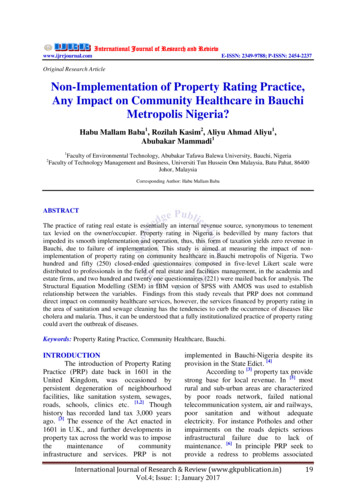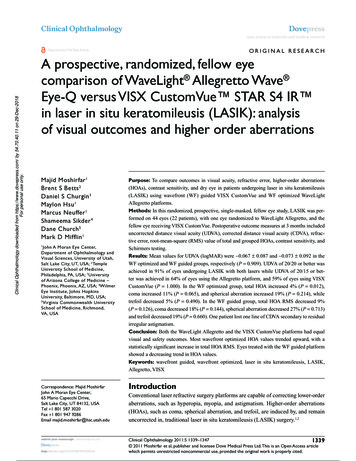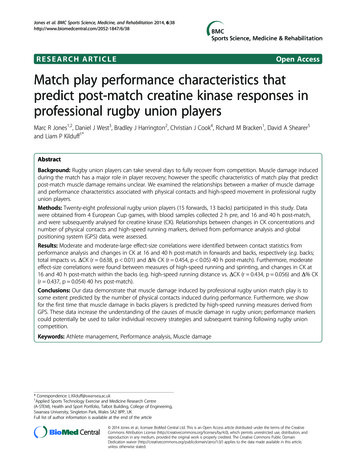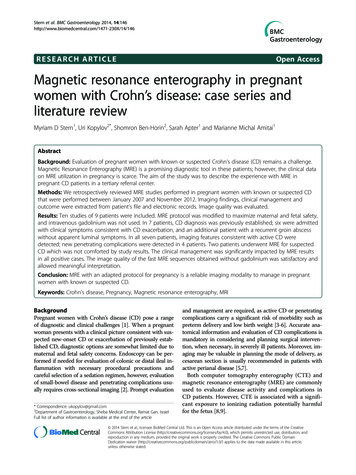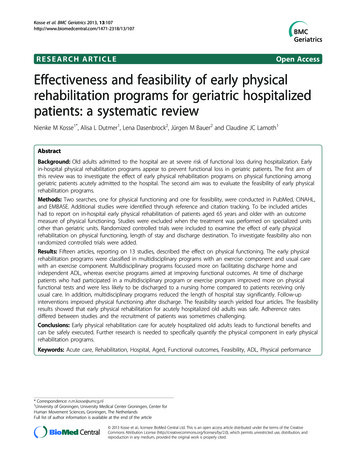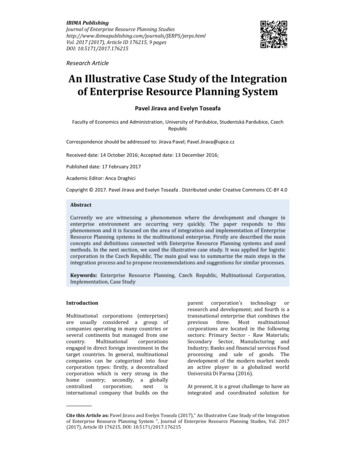
Transcription
IBIMA PublishingJournal of Enterprise Resource Planning PS/jerps.htmlVol. 2017 (2017), Article ID 176215, 9 pagesDOI: 10.5171/2017.176215Research ArticleAn Illustrative Case Study of the Integrationof Enterprise Resource Planning SystemPavel Jirava and Evelyn ToseafaFaculty of Economics and Administration, University of Pardubice, Studentská Pardubice, CzechRepublicCorrespondence should be addressed to: Jirava Pavel; Pavel.Jirava@upce.czReceived date: 14 October 2016; Accepted date: 13 December 2016;Published date: 17 February 2017Academic Editor: Anca DraghiciCopyright 2017. Pavel Jirava and Evelyn Toseafa . Distributed under Creative Commons CC-BY 4.0AbstractCurrently we are witnessing a phenomenon where the development and changes inenterprise environment are occurring very quickly. The paper responds to thisphenomenon and it is focused on the area of integration and implementation of EnterpriseResource Planning systems in the multinational enterprise. Firstly are described the mainconcepts and definitions connected with Enterprise Resource Planning systems and usedmethods. In the next section, we used the illustrative case study. It was applied for logisticcorporation in the Czech Republic. The main goal was to summarize the main steps in theintegration process and to propose recommendations and suggestions for similar processes.Keywords: Enterprise Resource Planning, Czech Republic, Multinational Corporation,Implementation, Case StudyIntroductionMultinational corporations (enterprises)are usually considered a group ofcompanies operating in many countries orseveral continents but managed from onecountry.Multinationalcorporationsengaged in direct foreign investment in thetarget countries. In general, multinationalcompanies can be categorized into fourcorporation types: firstly, a decentralizedcorporation which is very strong in thehome country; secondly, a globallycentralizedcorporation;nextisinternational company that builds on theparent corporation's technology orresearch and development; and fourth is atransnational enterprise that combines thepreviousthree.Mostmultinationalcorporations are located in the followingsectors: Primary Sector - Raw Materials;Secondary Sector, Manufacturing andIndustry; Banks and financial services Foodprocessing and sale of goods. Thedevelopment of the modern market needsan active player in a globalized worldUniversità Di Parma (2016).At present, it is a great challenge to have anintegrated and coordinated solution forCite this Article as: Pavel Jirava and Evelyn Toseafa (2017)," An Illustrative Case Study of the Integrationof Enterprise Resource Planning System ", Journal of Enterprise Resource Planning Studies, Vol. 2017(2017), Article ID 176215, DOI: 10.5171/2017.176215
Journal of Enterprise Resource Planning Studies2businesses. Companies have a variety oftools and various information technologiessuch as the Internet; electronic datainterchanges (EDI) to reach the bestpossible integrated solutions. In the past,the situation was different. The maininstrument of competition was price andquality. Consequently, it was necessary toincrease flexibility and responsiveness andother competitive objectives. The solutionto these problems, among others becameglobal outsourcing of activities and systemintegration.Extensive globalization has an impact onintegration in business- the economicglobalization and internationalization ofoperations are important features in theintegration of business partners andsuppliers across national borders. Theobjective of this process is to achieve anintegrated SCM. According to Yusufa andGunasekaranb (2004), there are manyexamples of successful and less successfulimplementations of such systems. Thereasons are mainly:-High complexity of the problem,- High cost,- High time demands,- High demands on other resources.Research MethodologyFor solution (see fig. 1), synthesis andsystem analysis were used. In the bookCpress (2014) "synthesis" is defined as themental connection of individual parts into awhole. In the synthesis, we focused on themutual substantial relation between theindividual components of the phenomenon,which helps to reveal the functioning of theevolution of the phenomenon. Theobjective of the system analysis (as ascientific method) was to explain theproblem by intensive examination of itscomponents.Basic scientific methods used during ourresearch were review of the literatureresources, analysis and illustrative ionanddevelopment of ERP systems designmethodologiesfromanacademicperspective, for example in Yusufa andGunasekaranb (2004), Davey (1991), ALSawaie B., et al. (2015), Gale (2002),Markus et al. (1999), Nazemi et al. (2012),Hwang (2011), Hwang (2011), Ross(1998), Černá (2015).The necessary data were subsequentlycollected in a selected logistic company.The main tool for gathering the data wasthe interview. The procedure was asfollows:- Prior to each interview, basic corporateinformation was gathered and analysed.- Face to face interviews were conductedwith the company managers.- Gathered data were analyzed andsummarized.Figure 1: Proposed steps of solution.Pavel Jirava and Evelyn Toseafa (2017), Journal of Enterprise Resource Planning Studies,DOI:10.5171/2017.176215
3Journal of Enterprise Resource Planning StudiesCase study is often comprehended as anattempt to understand and interpretphenomena or events which are defined ina final time and space. In this text,illustrative case study was used. IllustrativeCase Studies are descriptive; usuallydescribe an unfamiliar situation and try toexplain it to the reader; to understand theproblem uses examples, Davey (1991).Case study has the following features:-Is created based on real situations, fromreal life.-Its solution is divided into steps.-Each step is summarized, ends with pointsfor discussion.-Includesinformationneededtounderstand the problems.-Is credible.According to Soy (2016), case studies arevery complex because they generallyinvolve multiple sources of data and caninclude multiple cases. Soy (2016) alsostated that: “The advantages of the casestudy method are its applicability to reallife, contemporary, human situations andits public accessibility through writtenreports”.adjustments that often test human factors’abilities for efforts and investigations. Themaking and development of ERP typesystems have been and are still believed tobe the answer to such problems ensuringcertain aid to process huge amounts of dataand information needed in companies’choice-making processes. An ERP systemhelps the combination of a company’s set ofinformation into one platform due to theway in which it succeeds in combiningbusiness management techniques andpractices with the new informationtechnology, providing the clarity of dataand the approach to the necessaryinformation, Gale (2002).ERP systems are most commonly used in adistributed and often widely scatteredmanner. When we talk of ERP buildup,there are two basic groups. Typical two-tierarchitecture, the server handles bothapplication and database duties. The clientsare in charge of presenting the data andpassing user input back to the server.While there may be multiple servers andthe clients may be divided across severaltypes of local and wide area links, thisdistribution of processing burden remainsthe same, Eresource (2016).Enterprise Resource Planning SystemsERP Systems are software applications thatmerge data and or fuse the functionality ofclassical separate software systems.Examples of software systems that ERPsoftware might replace or fuse data frominclude accounting software, productstockpile software and many others.Usability First, (2016). About ten years ago,ERP systems were basically used by hugecorporations. In the era of cost effective ageWeb utilizations, many smaller businessesare finding that they can save costs byenforcing a light ERP system to carry outproduct sniff out, invoicing, and accountingpractices Techtarget Groupware (2016),AL-Sawaie B., et al. (2015).The changes in business climateshappening more, more frequently, andcompany activities’ becoming more andmore complex, require stable, fastIn three-tier construction, the database andapplication activity are separated (seefigure2). This is very typical of hugeproduction ERP deployments. In this case,satisfying client requests two or morenetwork connections. At the beginning, theclient creates communications with theapplication server. The application serverthen creates a second connection to thedatabase server.ERP integration in the corporationThe system integration is closely connectedwith its implementation. on (Voss 1989) are importantsteps leading to achieving high financialand business returns, improving businessinfrastructure and improving performance.According to Hwang (2011), there arevarious aspects of integration and thesePavel Jirava and Evelyn Toseafa (2017), Journal of Enterprise Resource Planning Studies,DOI:10.5171/2017.176215
Journal of Enterprise Resource Planning Studies4aspects relate to organizational, systems,technical, and strategic integration.Organizational integration ensures theintegration of external and internal a,people,money;Technical integration focuses on thetechnological level of the n can be internal or external andfocuses on communication of employeeswith access to an integrated system andphysical entities, Hwang (2011). In ourstudy, we focused on those selected aspectsrelated to the successful implementation ofERP.Figure 2: Three Tier ERP Architecture (according to Eresource (2016))ERP implementation should rather be abusiness project than n covers a wide range ofactivities including planning, developingthe initial business case, developingsoftware, configuring and implementingthe packaged software, and businessprocess improvement (Markus et al.(1999)). Implementing a new ERP systemin a company is a systematic process withdefinite steps (phases). Six phases areinvolved in the implementation process inany real company. These are the Discoveryand planning, design, development, testing,deployment and the ongoing supportphase.There are many approaches to ERPimplementation - Nazemi et al. (2012),Welti (1999), Hwang (2011), Parr (2000).Ross (1998) developed a five phase ERPimplementation process model. Markusand Tanis (1999) developed a four phaseERP implementation process model. Thesetwo approaches are the basis for the fourphase process model as shown by figure 3.It is generally accepted that integrationinvolves not only implementing ERPPavel Jirava and Evelyn Toseafa (2017), Journal of Enterprise Resource Planning Studies,DOI:10.5171/2017.176215
5Journal of Enterprise Resource Planning Studiessystems but it also involves integratingCustomerRelationshipManagement(CRM), e-procurement and ProductLifecycle, Awad (2010).The first phase is usually the planningphase. The essential part of this phase isthe draft of the project plan. The projectteam is also created and responsibilitiesare determined. In the ERP design phase,the main focus is on how the newenterprise wide systems will look and theirusage in the organization. It alsoemphasized the creation of a system’sconfiguration that will increase the systembenefits and the return on investments.Figure 3: Four phase process (Černá et al. (2015)The main goal of the development is toprepare the ERP system for going live.Specialistspreparethesystemenvironment for data migration andcustomization. Usually, the developerscreates testing environment. Testing isvery important to check if the system’sfunctionality is in an alignment with theoutlined requirements of the projects.During the deployment phase the analysthelps to implement the new informationsystem. This phase also includes usertraining. Last phase is support andmaintenance, AL-Sawaie B., et al. (2015),Nazemi et al. (2012), Hwang (2011), Klčováet al. (2009).Description of the companyIn the next part of the study we will focuson the real logistics corporation. Forpurposes of this text the term “Company”will be used. It is a private company whoseheadquarter is located in Kempten,Germany; it is presently one of the toplogistics providers around the globe.Company renders services such ascomprehensivetransportlogistics,warehousing, and customized services intwo business fields which are; Company Air& Sea Logistics and Company RoadLogistics. Company Road Logistic is dividedinto two business lines, Company EuropeanLogistics and Company Food Logistics.Company generated total revenue of 5.3billion EUR in 2014. The entire group usesSAP products. (Webinar On Demand:Dachser (2016)). In 1992, Company CzechRepublic was set up as an independentcompany for national and internationaltrust logistics with customs warehouse andclearance services. A new division of AirLogistics was also set up in 1996 and wasregistered in 1998. The new departmentfor Sea logistics was certified in 2001 andthe brand registration was done in 2002. In2005, the food logistics was unveiled. Thecompany changed its previous name toCompany E.S.T. a.s. in 2006 and toCompany Czech Republic in 2010. It hasdirect connections to 3 EURO hubs and 8branches in the Czech Republic such asKladno, Praha, Hradec Kralove, Ostrava,Ceske Budejovice, Brno and Breclav.Company Czech Republic increased itsturnover by 26% to 2 billion CZK andtransported a total of 824,500 shipments.The tonnage realized during shipmentsreached almost 500,000 tons. Last year, itwas for the first time that Company CzechRepublic managed to reach the two billionturnover s threshold. Company in theCzech Republic employs more than 454employees, representing an annual growthPavel Jirava and Evelyn Toseafa (2017), Journal of Enterprise Resource Planning Studies,DOI:10.5171/2017.176215
Journal of Enterprise Resource Planning Studies6of more than 30%. Table 1 describes therevenue generated by Company CzechRepublic in 2013 and 2014 respectively.Table 1: Revenue of Company Czech Republic in 2013 and 2014 respectivelyIntegration in the company case studyThis section is programmed to process anddefine key ways for integrating the ERP inthe cooperation. In industry, the setting upof ERP systems should start with thediscovery and planning stage; this is thestarting point of the six stages involved inthe implementation process. This firststage begins during the sales process andmoves to the post-sale stage. During thisperiod, the project team is formed. Initialmeetings and documentations weredeveloped for the team to meet andidentify current issues and potentialsolutions for the setup of the ERP systems.An important part of this stage is formingthe project plan, which includes looking ata company’s corporate structure, lines ofbusiness, departments, product lines, etc.The team also dives into the businessprocesses such as quote to cash, procure topay, cash management, and period closing.The project plan serves as a modelthroughout the implementation process.Management of the organization makes aseries of review decisions to ascertainwhether to invest in a new ERP system orto repair or replace the existing systems ofthe company.The Company uses the traditional SAP R/3ERP system which offers buying andreporting activity in the areas of money,logistics, and human resource applications,enabling the sharing of data between thecompany s various business units ordivisions. The cost of implementing the SAPERP system in the Company Czech Republiccost over 1 million Euro. Data acquiredfrom Ramona et al. (2016) showed themost frequently implemented modules inthe enterprises (see tab.2).In our case, the SAP planning andproduction are the widest areas of SAP R/3 and hold the greatest number ofmodules. According to Missbach (2000),the planning modules manage all processestangled in the internal SCM, from rawmaterial purchase to final customerdeliveryandbilling.Table 2: Implemented modules (according to Ramona et al. (2013))Accounting module: 77.2%Payroll module: 60.4%Reporting and analysis module: 57.8%Marketing and sales modules:52.3%Fixed Assets modules:42.9%Delivery and supply module: 54.5%Budget and project Management modules:34.4%Pavel Jirava and Evelyn Toseafa (2017), Journal of Enterprise Resource Planning Studies,DOI:10.5171/2017.176215
7Journal of Enterprise Resource Planning StudiesManufacturing, processes, Launch and Control module :32.8%All modules fully integrated solution: 19.9%These functions relate with practicallyevery SAP R /3 module, from financial tohuman resources. The main logistic-relatedmodules are Sales and Distribution,Production Planning, and MaterialsManagement. SAP Sales and Distribution isthe second most used module in thecompany. Sales and Distribution entails thecomplete sales cycle from ordering andquotationsovershippingandtransportation to billing and customerpayment processing. Sales and Distributionsupports Electronic Data Interchange, fax,mail, and so on. Other useful characteristicsinclude immediate product availability andinformation dissemination by integrationwith material management and productionplanning. Due to seamless integration withfinancial accounting and controlling,receivables and revenues of the companyare immediately updated. Sales andDistribution generates a much higher loadthan FI because of the many steps toprocess a business case and the dataexchange necessary with other modules.Depending on the functionality of use, thehigh-performance load can quickly arise.Examples of such performance hot spotsare online availability check and pricefinding. To help keep the response times ontheremainingapplicationserversacceptable, the company has set up adedicated server to perform the availabilityto promise calculation within the standardSAP R /3.SAP Financial Accounting and Controllingare the fundamental bookkeeping modules.SAP financial modules gave the companythe whole array of accounting process withwide-range reporting support, especiallywith the controlling module. Key aspect ofthe financial accounting system is the realtime generation of the current balance. Theneeds of globalization dealt with supportfor multiple currencies, units, andlanguages, as well as national tax and legalregulations. The related modules are SAPEnterprise Controlling providing anexecutive management system, as well asfinancial consolidation for subsidiaries incountries with different legal regulations,Missbach (2000).The SAP human resources area of thecompany includes business processes forpersonnel administration such as applicantscreening, payroll accounting, travelexpenses, etc. and personnel developmentwhich includes workforce planning,seminar management and so on. Thebusiness processes associated with thehuman resource modules are countryspecific to adhere to national lawsconcerning employment, tax, benefits, andso on. Because these laws are subject tochange frequently, many enterprises use adedicated human resource system separatefrom the other systems to restrict thedowntime necessary when applying legalpatchestothehumanresourcedepartment, Missbach (2000). Otherfunctions (Docplayer (2016), such as Crossapplication modules, provide generalpurpose functionality independent ofspecific modules. However, an essentialfunctionality is Application Link Enabling.It automates the data exchange betweenindependentsystems.Thisway,Application Link Enabling creates theability to harmonize the databases ofdistributed SAP systems within thecompany.Conclusion and DiscussionAs stated in the introduction to the issuesof integration and ERP implementation,many studies were published. This is abroad area and outputs depend on theangle of view and objectives of theresearch. The main aim of this paper was todescribetheproblemsofERP
of Enterprise Resource Planning System ", Journal of Enterprise Resource Planning Studies, Vol. 2017 (2017), Article ID 176215, DOI: 10.5171/2017.176215 . Ross (1998) developed a five phase ERP implementation process model. Markus and Tanis (1999) developed a four phase



